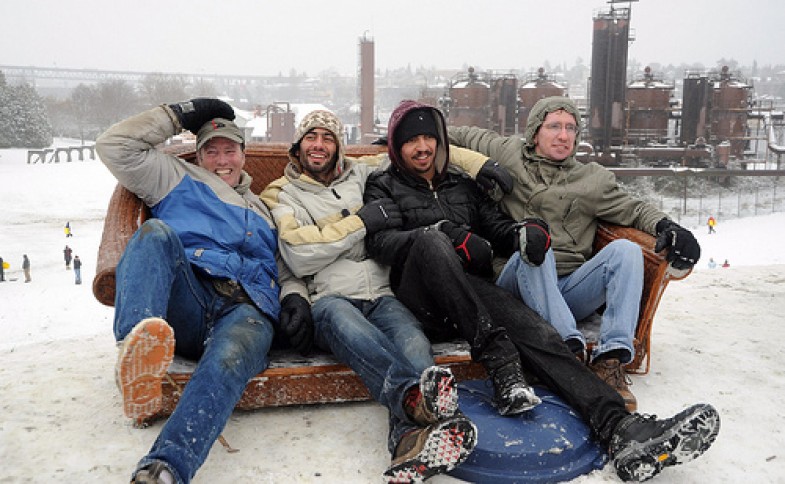Many people take vitamins to promote their health. Most vitamins come in tablet or capsule form and are sold in bottles. Recently, Richard Louv in his book, The Nature Principle, suggested a type of vitamin that doesn’t come in pill format. This is Vitamin N, with “N” referring to nature.
Louv’s basic theme is that we can become happier, healthier and smarter through more contact with the natural world. A growing number of pediatricians and other physicians are actually prescribing a daily dose of Vitamin N as a way to enhance our health and well-being.
Another key ingredient for better health is Vitamin C – not the kind from oranges, but from social connections. People with fewer social relationships are more likely to get physically ill and depressed than people who have close connections with others. Some research even suggests that the mortality risk of weak social relationships is comparable to that of smoking and alcohol abuse. Stronger social networks are associated in medical studies with greater immunity to infectious disease and better cardiovascular health .
Outside of cyberspace, social connections occur in a particular place – a park, community center, individual home, restaurant etc. -- with some places being more conducive to social interaction than others. In fact, the commons is so central to this form of social networks, we might call this health effect Vitamin C-3: community connections in the commons.
Consider the difference between a bank and a city park, for example. Our business in a bank is generally about money and is, for the most part, highly individualistic. We do our personal banking and then leave the building. We consider banking to be a transaction, not a social event. Going to a park, however, is an entirely different experience. Even if we go alone for a walk or a jog, we’re still immersed in a public place that invites social interaction. At the bank, we wait politely – and often silently -- in line. In the park, we may be more inclined to wave or nod – perhaps even offer greetings or friendly comments. Feelings of stress are more likely to surface at the bank, while de-stressing – feelings of calm and relaxation – are more likely to surface at the park.
Blue Zones
Some communities intent on helping their citizens live better and longer are working to become “blue zones.” The idea of the blue zone initiative began when explorer Dan Buettner teamed up with the National Geographic Society and other health researchers to identify places where people lived measurably better and longer. They found communities around the world where people reached age 100 at rates 10 times greater than in the U.S. average--and these became known as blue zones. Buettner and his researchers then looked for the lifestyle characteristics supporting such longevity. Strong social connections and a sense of purpose were identified as two of the key factors contributing to a long life lived well.
Buettner is now helping US communities become healthier. Establishing a community blue zone program for many communities means making permanent changes in the environment, public policy, and social networks.
Changes in the environment often focus on improving parks and other public spaces to bring people together. . Finding ways to make walking and biking more attractive is another priority because these activities foster social connections.
The Roseto Effect
The findings of Buettner and the National Geographic Society are strongly supported by other research focusing on longevity, well-being, and happiness. One longevity study of the 1960s focused on the residents of Roseto, a small town in Eastern Pennyslvania where were remarkably healthier and lived much longer than people in other towns similar in almost every way as measured by income, environmental quality, occupations, race, etc. An interesting fact about Roseto is that residents had 50 percent fewer heart attacks although they did not follow particularly healthy lifestyles. They smoked and ate fat-rich foods. The explanation – Rosetans lived in closely-knit families and had strong connections with their community. In other words, they lived long lives because they were nourished by frequent interactions with other people.
Researchers of the original study predicted that that “Roseto Effect” would fade once family and community connections of this largely Italian immigant community diminished over time due to social and lifestyle changes. This indeed happened as a 1992 study showed.
Vitamin Deficiency
Both Vitamin N (nature) and Vitamin C (connections) have proven health benefits, yet access to each of these is diminishing in today’s society. Historically humans’ daily lives were immersed in nature, but numerous technological, economic and lifestyle have changed that for most people. We spend the majority of our time indoors in climate-controlled buildings and cars while many of us live geographically distant from our families. More than one in four households in the US are now comprised of a single person. In 1900, this was one in twenty.
While the Internet allows social interaction across the globe and gives us many opportunities to connect with others sharing our individual interests, some studies suggest that time with electronic media is actually weakening family, neighborhood, and community ties. These studies show that Internet use and engagement with other types of electronic media tend to displace time formerly spent with family and friends.
Protecting and expanding the commons – places where we can connect with nature and each other – will pay big dividends in terms of the health and well-being of ourselves as individuals and as a community.

